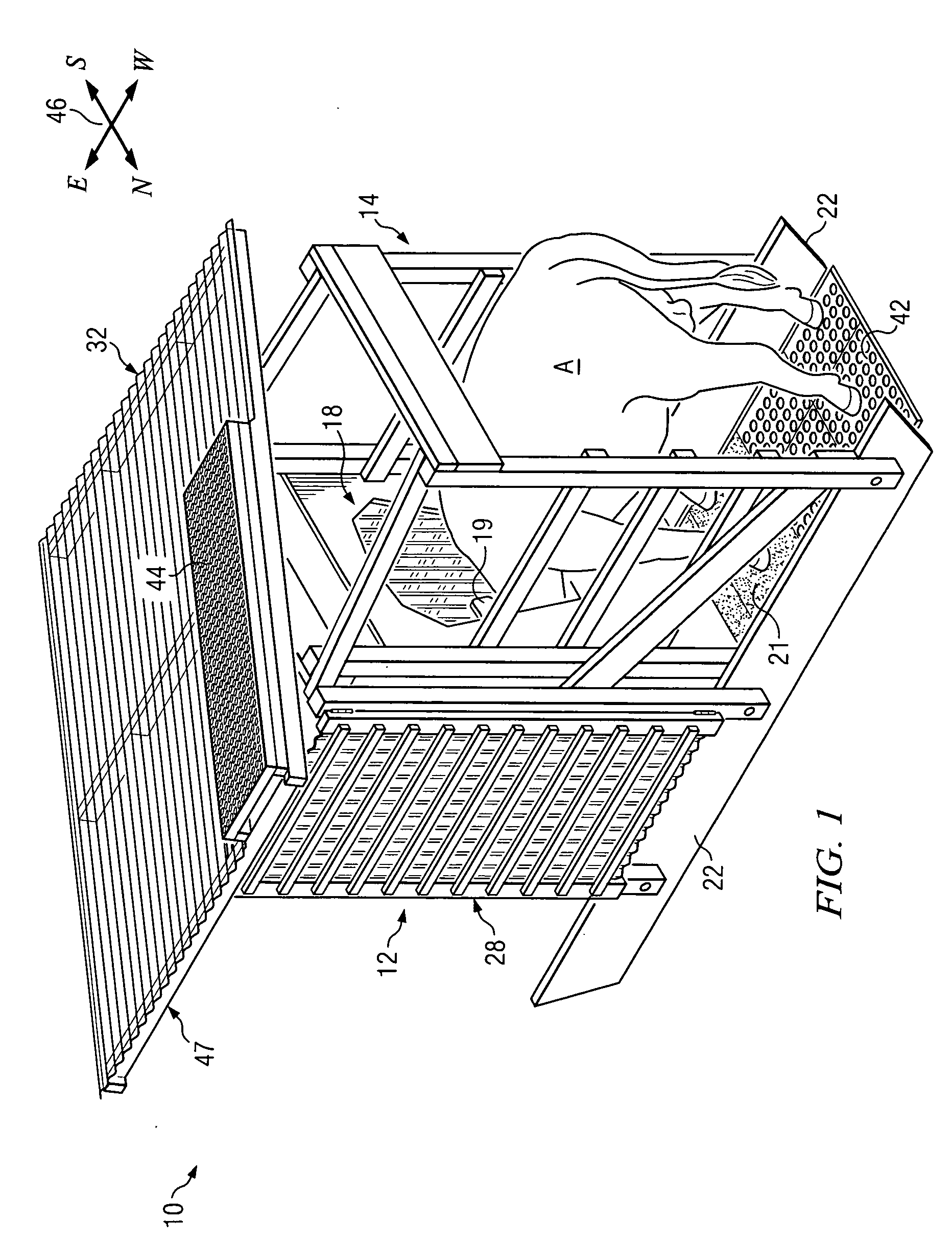System for monitoring animal feed consumption
a feed consumption monitoring and system technology, applied in the field of animal feed consumption monitoring, can solve the problems of difficult measurement of feed conversion efficiency of individual animals within a co-fed group under traditional feedlot conditions, and existing systems that have not been designed to operate autonomously with high reliability, and have not provided for feed protection
- Summary
- Abstract
- Description
- Claims
- Application Information
AI Technical Summary
Benefits of technology
Problems solved by technology
Method used
Image
Examples
first embodiment
[0018] Referring now to the Drawings, and particularly to FIGS. 1, 2, 3, and 4 thereof, there is shown a system for monitoring animal feed consumption 10 comprising the present invention. The system comprises an enclosure 12, a stall 14, and a portal 18 located between the enclosure 12 and the stall 14. The stall 14 can be a separate structure normally secured to the enclosure 12 and detachable therefrom for transport, etc. The stall 14 and the portal 18 can also be attached to or located inside of a pre-existing outdoor enclosure or barn. Alternatively, the portal 18 can be deployed separately as a stand alone device in appropriate circumstances.
[0019] In and of itself the portal 18 comprises an important feature of the invention. The portal 18 includes an intrusion 19 having an RFID antenna 20 secured to the inside surface thereof. The specific shape and placement of the intrusion 19 is such that an RFID tag secured to the ear of an animal utilizing the system 10 passes by the ant...
second embodiment
[0035] Referring to FIG. 7 there is shown a system for monitoring animal feed consumption 80 comprising the present invention. Many of the component parts of the feed monitoring system 80 are substantially identical in construction and function to component parts of the feed monitoring system 10 illustrated in FIGS. 1 through 6, inclusive, and described hereinabove in conjunction therewith. Such identical component parts are designated in FIG. 7 with the same reference numerals utilized above in the description of the feed monitoring system 10 but are differentiated therefrom by means of a prime (′) designation.
[0036] The feed monitoring system 80 differs from the feed monitoring system 10 in that the feed monitoring system 80 comprises two feed bins 36′ within an enclosure 12′. Accordingly, the enclosure 12′ comprises a second access portal 18′ with its own RFID antenna installed thereon and a second stall 14′ having a second sensor 40′ therein. The enclosure 12′ further comprises ...
third embodiment
[0037] Referring to FIG. 8 there is shown a feed monitoring system 82 comprising the present invention. Many of the component parts of the feed monitoring system 82 are substantially identical in construction and function to component parts of the feed monitoring system 10 illustrated in FIGS. 1 through 6 and described hereinabove in conjunction therewith. Such identical component parts are designated in FIG. 8 with the same reference numerals utilized above in the description of the feed monitoring system 10 but are differentiated therefrom by means of a double prime (″) designation.
[0038] The feed monitoring system 82 differs from the feed monitoring system 10 in that the feed monitoring system 82 comprises four feed bins 36″ within an enclosure 12″. Accordingly, the enclosure 12″ comprises four access portals 18″, each with its own RFID antenna installed thereon. Each access portal 18″ has a stall 14″ adjacent thereto with a sensor 40″ installed in each stall 14″. The enclosure 1...
PUM
 Login to View More
Login to View More Abstract
Description
Claims
Application Information
 Login to View More
Login to View More - R&D
- Intellectual Property
- Life Sciences
- Materials
- Tech Scout
- Unparalleled Data Quality
- Higher Quality Content
- 60% Fewer Hallucinations
Browse by: Latest US Patents, China's latest patents, Technical Efficacy Thesaurus, Application Domain, Technology Topic, Popular Technical Reports.
© 2025 PatSnap. All rights reserved.Legal|Privacy policy|Modern Slavery Act Transparency Statement|Sitemap|About US| Contact US: help@patsnap.com



